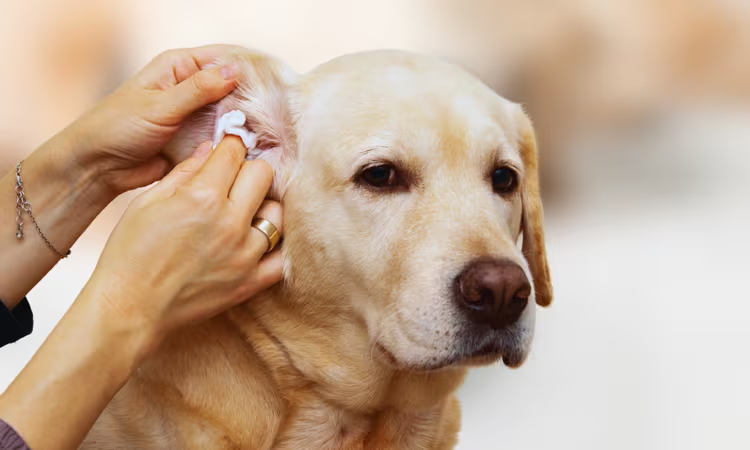You’re scratching your head, holding a tube of Monistat, while your dog is over there scratching… well, just about everything.
If your pup’s been licking, biting, or chewing at their paws or has some funky skin situation going on, it’s normal to wonder if that little over-the-counter antifungal cream in your medicine cabinet might do the trick.

But is it safe? Or are you about to make things worse?
Let’s break this down in a way that actually makes sense.
What Exactly Is Monistat, And Why Do Dog Owners Reach For It?
Monistat is a brand name for miconazole, a common antifungal that’s usually used for yeast infections in humans.
It works by stopping fungus from growing. So if your dog’s dealing with a yeast infection, it’s easy to think, “Hey, maybe this’ll help.”
People usually end up in this spot late at night, maybe after a long day, when they spot a red patch or catch a whiff of that not-so-lovely sour smell coming from their dog’s ears or skin folds. And with vet offices closed or out of reach, Monistat seems like a quick fix.
When It Might Be Okay To Use (But Not As A Guessing Game)
Here’s the thing: miconazole isn’t automatically dangerous for dogs. In fact, vets sometimes prescribe it in dog-safe formulas for yeast infections, ear issues, and skin flare-ups.
But those versions are usually mixed with other pet-safe ingredients, made in the right strength, and used under medical guidance.
If your dog’s got a mild skin yeast infection and you’ve used Monistat under a vet’s recommendation before, it might be okay to apply a small amount to the affected area.
But “mild” is the key word here. If your dog is raw, bleeding, crusty, or oozing anything weird, put the cream away and call your vet.
Real Talk: What A Yeast Infection Looks Like
A lot of folks mistake regular itchiness for a yeast infection. But the signs that usually show up with yeast include:
- That corn chip or musty smell
- Red, irritated skin in moist areas like armpits, paws, ears, or belly folds
- Sticky brown gunk in the ears
- Excessive paw licking or scooting
Yeast thrives in warm, damp places, so dogs who swim a lot, live in humid spots, or have allergies are more prone to it.
But remember, skin issues can also be caused by bacteria, parasites, or even food reactions. That’s why it helps to know what you’re dealing with before you try to treat it.
How To Use It If You Really Need To
Let’s say you’ve talked to your vet, or you’re in a pinch and they’ve told you it’s okay for temporary use. Here’s how to keep it safe:
- Clean the area with a damp cloth and pat it dry
- Use a pea-sized amount for small patches
- Apply gently, avoid open wounds
- Don’t let your dog lick it off (you may need a cone or dog shirt)
- Use once or twice a day for no more than a few days
Watch closely. If the skin gets worse, or your dog acts lethargic or uncomfortable, stop using it and get professional help.
Alternatives If Monistat Isn’t Ideal
If you’re not comfortable using Monistat, or your dog has a reaction to it, there are other options worth trying. Look for:
- Vet-prescribed antifungal creams or sprays
- Chlorhexidine wipes (great for yeast-prone areas like paws and folds)
- Natural remedies like diluted apple cider vinegar (used carefully and never on broken skin)
- Medicated shampoos made specifically for yeast or fungus
Just make sure the product you pick is actually labeled for dogs. What works for people doesn’t always work for pups.
Don’t Just Treat The Skin, Fix The Cause
Yeast infections are often a symptom, not the main issue. Food allergies, environmental triggers, humidity, or poor grooming habits can all lead to overgrowth.
So if you’re treating flare-ups over and over again, it’s probably time for a deeper look.
A dog that keeps licking their paws at night, scratching their belly, or shaking their head like mad might have more going on under the surface.
That’s where allergy testing, dietary changes, or long-term treatment plans come in.
Keep Things Clean During Treatment
If your dog has a yeast flare-up, odds are the spores are spreading through fur, furniture, and floors. Regular cleaning helps stop the cycle.
- Wash their bedding every few days
- Vacuum often, especially carpeted areas
- Use pet-safe disinfectant on floors and couches
- Give them regular baths with vet-recommended antifungal shampoo
It sounds like a lot, but once you get into a rhythm, it’s easier to manage than dealing with back-to-back breakouts.
When To Put The Cream Down And Call The Vet
Home care has limits. If you see any of the following, don’t mess around:
- Skin is raw, bleeding, or swollen
- Infection spreads fast or covers large areas
- Your dog is acting weird or super uncomfortable
- The cream isn’t doing anything after a few days
- You’re not sure what’s causing the issue
Some conditions that look like yeast could actually be bacterial or parasitic. The wrong treatment could make things worse or delay proper healing.
Trying to help your dog feel better with what you have at home is completely understandable.
We’ve all stood in the hallway, Googling symptoms while our pup looks at us like we’re supposed to fix everything right away. And sometimes, a little knowledge and caution go a long way.
But when it comes to creams like Monistat, make sure you’re not trading short-term relief for a long-term mess. It’s always better to call your vet and double-check before playing doctor.
Have you ever tried treating a mild skin infection at home? What worked best for your dog?